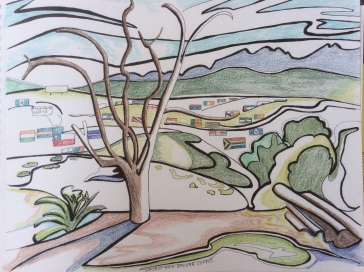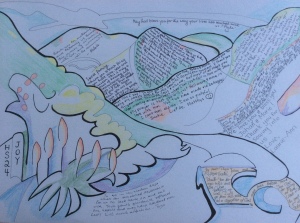
by Laurie-Ann Copple (July 2005 – Migori, Kenya, updated July 2014)
[Note: This is not part of the Ways to Grow in God series, but rather one of my talks from missions. It is a lot more wordy, but I hope it blesses you dear reader!]
Throughout church history, missionaries, pastors and evangelists have struggled how best to communicate the Gospel to their own people and to many other people groups – tribes, nations and language groups. Each group of people has a different way of living according to where they reside. These traditions, ways of life, types of food, music, and ways of speaking are all different in each culture.
In church history, some missionaries debated with each other on what is better – to completely wipe out the culture of the people they are winning to the Lord, or to use parts of that culture as a KEY to that culture being used for the Lord. The view of wiping out the culture (both good and bad aspects) involves starting on a ‘clean slate’; and to start over again with a new ‘godly’ slate. This view understands that cultures that do not love Jesus and follow his holy ways, as all ‘bad’, like tainted meat, or bad water that makes you sick. The people with this view believe that it is better to just start again. Some of the 14th century missionaries in China tried this way of working with new Christians. They called it tabula rasa, or ‘clean slate.’
Other missionaries (including the Apostle Paul) chose to work within the culture. They would transform parts of it as a tool for the gospel. This was necessary to communicate the gospel in a way the surrounding culture would understand. It was also necessary to model a holy life to the new Christians where their outreach was based. These are bridges to the gospel.
The Apostle Paul was in Athens during one of his missionary journeys. While he was prayer-scouting, he found many idols and altars to false gods, and these upset him. But he turned this around by using something he found to help communicate the gospel. He found the altar to the “unknown God.” If the people were seeking who they didn’t yet know, this provided the bridge Paul needed. So Paul stood before the Athenian leaders, and told them that they were indeed seeking after the living God. He said, “Men of Athens! I see that in every way you are very religious. For as I walked around and looked carefully at your objects of worship, I even found an altar with this inscription: ‘To an unknown God.’ Now what you worship as something unknown, I am going to proclaim to you.” (Acts 17:23)
Paul (and many later evangelists) used philosophical viewpoints that were similar to the gospel as a bridge to Jesus. He brought these cultural perceptions to the Lord and then redeemed them in a way that brings God glory.
Another example of this is when Paul makes himself culturally sensitive to others, and becomes like them, “to become all things to all people, so that by all possible means (he) might save some” (1 Cor. 9:23). I often mention the importance of this cultural flexibility and presence when I am in teaching mode. I am convinced that the best way to work with Christ and our cultures (and even some of our traditions) is to use parts of them, and transform them for Jesus’ glory. Hudson Taylor did this in China, when he dressed, talked and ate like a Chinese man. He became as Chinese as he could, so he could reach the people he came to love in China.
I attended a worship and teaching conference in 1995 and met Northern Irish worship leader Robin Mark. While he was there, he taught us about redeeming musical instruments. Robin said that since the European Middle Ages, there has been worship styles have used aspects of the surrounding cultures and transformed them for Jesus. They took musical tunes that were popular and used them in worship songs, and added lyrics that taught many people about Jesus. These songs were full of good solid teaching.
Preachers began writing hymns in the time to Martin Luther (15th century), but they encountered resistance when they did so! Yet through their persistence, the church grew and was strengthened by worship the people could culturally feel “at home in.” Since these people felt validated, they would sing to the Lord from all their hearts. John and Charles Wesley were excellent 18th century circuit preachers. They rode horses many hours daily to preach throughout England. They were not just preachers, but also hymn-writers. Their hymns are so full of good teaching that they sustained the people who memorized and sang them. Wesley lyrics are literally a sermon in a song. They also used the popular music of the day as a soundtrack to growing in worship.
There have been many kinds of worship music since the time of the Wesleys! Each style has lifted up the Lord and given him glory. It is important to remember that each style can be anointed, even if the worship style is different than your own. God loves all tribes, nations, peoples, and culture is an expression from each of them. The important thing is that expressing heart-felt worship is very special to the Lord, and all kinds of instruments can be used to praise him.
When I was in Northern Ireland, I had a bodhran (Irish drum) made for me. Some Christians in my then-home church were upset that I brought this drum into the church for worship. They saw the drum as an instrument of war (or at least the traditional Irish pub bands). But once it was blessed and dedicated to the Lord, the sound it gave was a blessing, and it made the worship more beautiful. This drum was redeemed from a tradition of Irish war, or songs sung in bars, to instead be an instrument of praise. I have used it for years during worship in our weekly prison Alpha sessions.
Now, while I strongly believe in the redemption of culture, I am quite sad when some cultures are imposed upon others. I wish to apologize to Africans and Asians on behalf of many Westerners. Many North American or European missionaries thought their Western culture was more holy than African cultures and tradition. This is not true! Western cultures fight against our Lord Jesus almost as much as other cultures, just in different ways. The devil is as real in North America as he is in Africa, even if some Americans and Canadians don’t believe he exists. And so, I am sorry for the sins and mistakes of imposing much of Western culture on Africa. It is not better, it is just different. Many of the missionaries and colonial peoples imposed their own cultures on Africa, because they thought African culture was evil, and in some cases, this is true. However, these missionaries were blinded to the evils in their own cultures.
We are now living in an age where cultures are living side by side. People can move much more easily by air travel, and immigration has become a common thing in most areas of the world. Therefore, working within and across cultures is something we will all have to do. There are many people groups where I live in Canada. There is nearly every people group living in my home town of Toronto. That’s just the ethnic groups. Then there are the culture groups centred around style of music, demographics (age), faith group, lifestyle and hobbies. Africa also has the challenge of many cultures. African Christian pastors and evangelists minister to many people groups: some who aren’t Christians yet, new Christians, and those people in different tribes (who speak different tribal languages). Some people may have a traditional African background with different deep-set customs. They may have a Muslim background, or be Christian in name only. These people may be living a lifestyle that is not holy. They need to receive Jesus in their hearts and walk deeper in faith. They need to be discipled in holiness with lots of good teaching and much love. How do we work with the secular cultures around us in the business world and government? How do we work with the cultures of other faiths for the gospel? How do we work with those who are church-goers? They are part of the church culture, but they haven’t yet taken the step of really wanting to know Jesus. So many needs! But Jesus is still the answer, when you honour their culture! Listen, love and honour each person.
I will share five different ways of understanding Christ and culture from Richard Niebuhr. He wrote a book called Christ and Culture. [H. Richard Niebuhr, Christ and Culture. (Harper and Row, New York 1951, ISBN 0-06-130003-9)]. Each of these ways have useful points for living and ministering a Christian life in our cultures. But, I want you to think about what may suit you best in your own ministry. The challenge of Christ and culture affects both clergy AND lay people. We all are challenged as we seek to live for the glory of Jesus Christ – especially in a world that does not know him.
Christ against culture
The first view of wrestling with culture is to reject it or run from it. This view is called Christ against culture. The monks of the 4th century AD rejected the state church when Christianity became the state religion of the Roman Empire. These men thought that the new church goers and the newly approved Christianized culture was not holy enough. So these people became the desert fathers. They lived in deserts, in mountains and other remote places so they could try to become closer to God. But even this posed a problem: what languages did they use? What traditions did they follow or did they start new traditions?
However, there is still something in us that fights God through our own self-centeredness. We cannot fight our own tendency to sin on our own, and certainly not by running away from culture. All that does is to remove distraction. The Bible does tell us to flee from promiscuity and evil, but what of man-made culture itself? Are we to ignore the rest of humanity? Surely not!
Some people believe that all man-made culture and tradition is evil, because it is tainted by sin; and in some cases it may be directly demonized. Yet there is some good news about this viewpoint. It shows our need for God and so it is a turning point as a call to holiness. Men and women who have followed calls to holiness have often led to renewals and revivals throughout church history. Many people have a longing for heaven to come on earth, and a call for the Lord to take us home to heaven. The writer of Ecclesiastes (likely King Solomon) notes that God “has also set eternity in the human heart; yet no one can fathom what God has done from beginning to end.” (Eccl 3:11) This almost points to a sense of destiny. What can be a problem with this view is that it can forget our godly task of stewardship. This task is to take care of the land and ministries the Lord gives us, since we are working for him. However, God used the monks in early missions despite their desire to be left alone for God, although their time alone also recharged them and filled them up for ministry. We are not made to be on our completely own but to minister to each other. We are the Church.
Christ of Culture
This view is a form of accommodating culture so that the gospel is palatable rather than an offence. It is very common view in North America. Unfortunately this point of view hurts many of the churches. These people try to understand Jesus and his teaching through their own culture. They might select only the Christian doctrine that agrees with their own culture or theology. This is dangerous! Not only does it dilute the gospel in this generation, but it dissolves it further in later generations. Culture can easily change within one generation! This means that if you tie the gospel to culture in a way that this culture is viewed as part of the gospel, later generations will believe the gospel is “past it’s time.” In other words, the timeless gospel message is lost and you will need to re-evangelize the same places. Another hindrance is that people who took this version of the gospel to heart often get upset over minor changes in the cultural trappings. How many church splits happen over cultural differences? Far too many!
This viewpoint often diminishes Jesus’ divinity since he is viewed through the human cultural lens. Thus, Jesus is understood as a superhuman or only as a great moral teacher. The other extreme (Gnosticism) also simplifies Jesus as only divine. They see Jesus as a divine giver of wisdom that is not approachable by any of his lay followers but only by special clergy. The second view turns the gospel into a collection of stories and secrets to be interpreted only by specific people. That almost sounds like the era when laypeople could not read the Bible in their own language, doesn’t it?
In the humanized version of the Christ of Culture view, sin is not mentioned at all. Instead of the gospel of redemption, there is a ‘gospel’ of acceptance; even an acceptance of sin itself! The prophet Isaiah warned of a day when good is called evil, and evil is called good. Isaiah said, “Woe to those who call evil good and good evil, who put darkness for light and light for darkness, who put bitter for sweet and sweet for bitter.” (Isaiah 5:20) People of this view however, may be good in service ministry, and in mercy ministry – but the power of God (and in some ways the LOVE of God) is gone. This gospel isn’t just in the liberal churches. It’s also in some of the seeker friendly churches in North America. Take a look at David Wilkerson’s warning!
Beware!
Christ above culture
This viewpoint sees Christ and culture as two completely separate areas of life. These spheres of influence don’t conflict entirely, because all works of human cultures are deemed possible only by God’s grace. Government is meant to be honoured and prayed for, as Peter reminds us in 1 Peter 2:13 & 17. “Submit yourselves for the Lord’s sake to every authority instituted among men: whether to the king, as the supreme authority, or to governors, who are set by him to punish those who do wrong, and to commend those who do right […] show proper respect to everyone. Love the brotherhood of believers, fear God, honour the king.”
Jesus also acknowledged that culture and government were not to be rejected, when the Pharisees and Herodians asked him whether it was godly to pay taxes to the Roman government that had authority over Israel. Jesus asked for a coin, and asked whose face was on the coin. When he was told that it was the face of the emperor Caesar, Jesus said to “give to Caesar what is Caesar’s and to God what is God’s.” (Mark 12:17).
This view advises us to give the best of our cultures and to be stewards of a new ‘Christian culture.’ This is not to mix Jesus with the present culture, but it is something entirely new.
Christ and culture in paradox
This view of Christ and culture is especially shown in the 16th century reformer Martin Luther. He and others with this view believe that since we are Christians, we live our lives in conflict. We are part of the surrounding culture in some ways, but not in others. We are in the world but not of it. All cultures, traditions and ways of life are seen as tainted, but it is still necessary to work hard and do your best to the Lord. What matters in this view is to maintain a Christian heart of love, a holy lifestyle, and to focus on Jesus (while waiting for his return).
Jesus’ light shows the unrighteousness of every human work. We must be honest. We often want to be in control of our own work and ministry, instead of God. We want to feel right. We want to feel important. This self focus, or absorption, is in all of our cultures. So Luther believes that secular vocations could become as much a calling as being a pastor if it is done with Christian commitment and integrity. These included vocations like: Medicine, music, law, policing, government, business, teaching and many other careers. The Apostle Paul advised us that whatever we do, do it as unto the Lord. Otherwise, we are to do good in the tainted world until Jesus comes back for us.
Christ the transformer of culture
This is the most hopeful view of Christ and culture, and the one that I believe makes the most sense. It has a true understanding of the nature of sin. Yet, it sees history as a continuing story of God’s mighty deeds, as well as people’s response to the Holy Spirit calling them. It is a renewal-focused view, and it allows for God’s presence to show the church a taste of what heaven is like; even before Jesus returns!
This view seeks to redeem and transform much of cultures as tools for the Gospel. It is much more positive than the other views. People can be redeemed, so why not culture as well? The Apostle Paul used the altar of the unknown God as a bridge of understanding to reach the Greek seekers in Athens (Acts 17:23). Other missionaries use redeemed parts of national cultures as a bridge for the gospel. These bridges become keys to the hearts of those national peoples. In a sense, God has placed bridges in most philosophies and faiths. It is like a preparation for when people encounter the real living God.
The Apostle John explains the greatness and glory of Jesus Christ to the Greek thinkers in the Gospel of John. He had to use their concepts to help them understand who Jesus really was; fully human, but fully divine. Some philosophers in ancient Greek culture believed that there was a perfect original of everything beautiful on earth. This is especially shown in Plato’s concept of “forms.” Everything good on earth is just a copy of everything that is perfect in heaven. If there was a beautiful chair on earth, it is merely a copy of the original chair in heaven. The “heavenly chair” is more beautiful than the “earthly chair.” This would be like the concept that earthly chairs are copies of God’s actual throne chair. The chair is just the example. It could be anything good and beautiful, especially if it points to heaven.
John transformed the understanding of forms when he wrote the Gospel of John. He called Jesus the “Word,” or the Logos, in Greek. The Greek philosopher Plato had taught that the Logos was the ultimate being of life, knowledge, truth and wisdom, and the Logos ruled by his order of the universe. John used the Greek philosophic understanding of Logos to teach Greek believers about Jesus’ divinity and that He is not a created being. Jesus did not “begin” his existence when he was conceived by the Holy Spirit and born of the Virgin Mary. Jesus, like the Father and the Holy Spirit, was here before the beginning, and will be here after the end of time. He is eternal and lives forever! Yet, eternity means more than the concept of un-ending time, or living beyond time. Eternity also shows itself where God breaks through to us with his supernatural power in our own time.
God, through Christ, by the Holy Spirit, redeems the cultural institutions we bring him! He transforms them into something better – something he can work through to reach the people that he is calling to him.
So in conclusion, Niebuhr says in his book Christ and Culture, that this is no single Christian answer to live out the problem of Christ and culture. This is where YOU must seek God individually and as groups, to decide how culture can be redeemed and prayed for. The Holy Spirit can also guide you in discerning which evil parts of culture can be avoided, and what can be used to help preach the gospel.
Here is but one example for African pastors: how about the combining naming ceremonies with a service of dedicating children to the Lord? I know there are many more examples. Please, as you consider this teaching, keep asking the Holy Spirit how he would guide you. Jesus is the redeemer, and I believe that he would use you to reach the surrounding cultures where you live. It is only a matter of his timing, discernment and your willingness to be used for his glory.
Bwana Asifiwe! (Praise the Lord in kiSwahili)
Blessings, Laurie-Ann Copple (Sister Ann)
Laurie-Ann is an Ottawa based media person. She has been on missions in Kenya, Sierra Leone, Northern Ireland and Pakistan. She is hoping to work in long term missions and is in discernment mode for direction. Meanwhile, she attends St Paul’s Anglican Church in Kanata, and Kingdom Culture Ministries in Gloucester, Ontario (Canada).
(Here is a diagram of another way to view the Niebuhr book):










You must be logged in to post a comment.